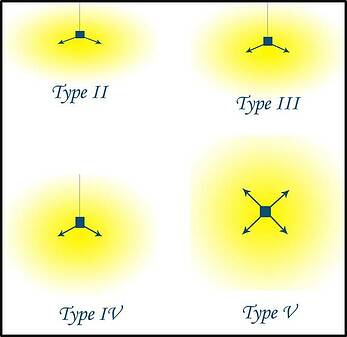Energy Efficient Lighting: What Are Light Distribution Patterns?
Why Do You Need To Know This Stuff?
It's simple, you want to get the right type of lighting, period. As a building owner you don't want to spend money and not get results, so getting a better understanding of the technical aspects behind your lighting project is in your best interest.
That way, no one can trick you into spending money on something that will not accomplish your goals. When looking at outdoor lighting, it is very important to understand the concept behind light distribution.
If the light is not distributed correctly, it can't be changed without re-doing the project. Do it right the first time and get a better understanding of lighting distribution patterns.
All About Lighting Distribution Patterns
Outdoor luminaires produce lighting patterns that can be identified first by their reach in front of a single fixture location and second by their reach on each side of that location.
“Distribution types” describe the reach of the luminaires light pattern forward of each fixture, while “distribution ranges” define the reach to either side.
Distribution Types
The term “distribution type” defines how far forward of the luminaire (i.e., on the street side) the effective output reaches.
The specific classification of distribution types is based on locating the luminaires effective major output pattern on a grid representing distances in units of Mounting Height (MH) from the luminaire.
This pattern is defined by tracing an area representing light distribution at 50% of maximum candela. By measuring where the bulk of this pattern falls on the grid, a luminaire can be classified as follows and as shown in this illustration below.

(Note that in some cases, minor deviations in a beam pattern may cross the boundary from one type into another. While this has a nominal effect on applied performance, it should not be considered for classification purposes):
- Type II defines shallow reaches, when the 50% maximum candela trace lies within1.75 MH on the street side of the reference line.4
- Type III is a mid-range, when the 50% maximum candela trace lies within 2.75 MH on the street side of the reference line.4
- Type IV identifies luminaires with a definite forward-throw distribution, when the 50% maximum candela trace lies beyond 2.75 MH on the street side of the reference line.4
- Distribution is classified as Type V Square for horizontal lamp luminaires when the 50% maximum candela trace is symmetric in four quadrants. This distribution is characterized by four candela peaks, diagonal to the reference line.
- Asymmetric5,6 Distribution (similar to Type III): This distribution is for vertical lamp luminaires when the 50% maximum candela trace lies beyond 1.0 MH on the street side of the reference line, and inside 1.0 MH on the house side of the reference line. Narrow range distribution is identified when the point of maximum candela falls inside of 2.25 MH; wide range is identified when the point of maximum candela falls beyond 2.25 MH.
- Symmetric5,6 Square Distribution (similar to Type V Square): Distribution is classified as symmetric square for vertical lamp luminaires when the 50% maximum candela trace is symmetric in four quadrants on both street and house side of the reference line. Narrow range distribution is identified when the candela peaks fall inside of 2.25 MH along the reference line; wide range is identified when the candela peaks fall beyond 2.25 MH.
(Source: www.maxlite.com)
A Bit Too Technical?
Easy to get lost in symmetrics, asymmetrics, type this type that....but if your confused, no worries, we can help you out. By taking the dimensions of the outdoor area you want to re-light, we can help you get the correct distribution pattern by developing a photometric layout of your area.
A photometric layout is the only way to insure you are getting the light distribution you need from either your existing fixtures or new fixtures you may be considering. Just click below and we will provide a FREE consultation regarding your energy efficient lighting project....